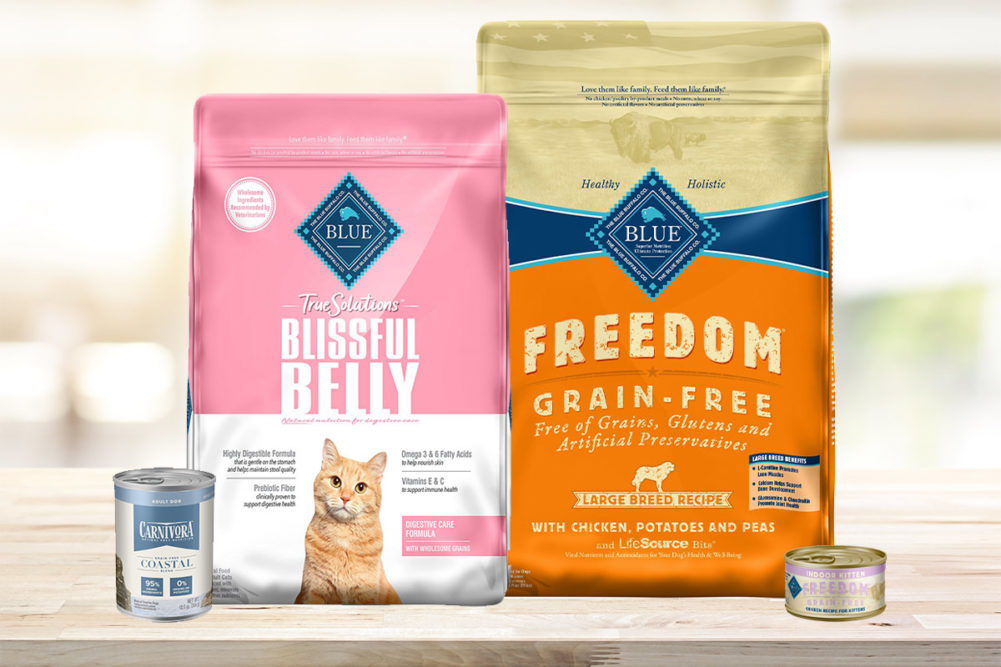MINNEAPOLIS — The Blue Buffalo brand continued to perform well for General Mills in its full fiscal year 2021 ended May 30, with household penetration, awareness and omnichannel gains driving growth.
Pet segment revenue was up 2% to $1.73 billion for the full year. Retail sales for Blue Buffalo increased by double-digits, resulting in an expanded market share for the pet food and treat brand.
Segment profit for General Mills’ pet business was up 6% to $415 million, attributed to higher net sales, lower SG&A expenses and partially offset by higher input costs, the company stated. The company shared annual net sales for its pet segment were up 10% on a two-year compound growth basis (CGB).
“The brand also drove further household penetration gains and increased pet parent awareness with our omnichannel growth model,” said Kofi Bruce, chief financial officer of General Mills.
Pet segment sales were down 20% to $444 million in the fourth quarter of fiscal 2021 compared to year-ago revenue. General Mills attributed this to two factors. The company’s fiscal-year calendar for 2020 included an extra month of financial results, which has resulted in an incongruent year-to-year comparison.
Additionally, last year’s fourth quarter sales represented a “pandemic-driven stock-up demand” that was not repeated this year. This caused pet segment sales to reach $555 million in the fourth quarter of fiscal 2020, soaring above the segment’s historical quarterly net sales.
“Importantly, retail sales for BLUE in the fourth quarter were up mid-teens in measured channels, reflecting the underlying strength of our business,” Bruce said.
Fourth-quarter segment operating profit for pet declined 24% to $103 million compared to the fourth quarter of fiscal 2020, which was the result of higher input costs and lower volume.
The two-year CGB rate for the pet segment, which removes the extra month impact from fiscal 2020, puts fourth-quarter sales for pet up 5%.
In May, the company announced its intentions to acquire Tyson Pet Products from Tyson Foods, Inc. for $1.2 billion. The company expects the acquisition deal to be completed in the first quarter of its fiscal year 2022, which will be later in 2021. This marks General Mills’ first acquisition since it purchased Blue Buffalo Company in fiscal 2018, shared Jeffrey L. Harmening, chairman and chief executive officer.
“The Tyson portfolio, which includes the Nudges, True Chews and Top Chews brands, is the leader in natural meat treats and is highly complementary to our existing pet treat portfolio under the BLUE brand,” Harmening said. “Annual net sales for the Tyson pet treat business totaled more than $240 million and have grown at nearly a 20% compound rate over the past three years. We see significant opportunities to drive future growth by expanding awareness and availability of these products and we expect to unlock production and other cost synergies with the rest of our pet business, all of which will result in substantial value creation.”
Overall, General Mills reported fiscal 2021 net income for the period ended May 30 was $2.34 billion, equal to $3.78 per share on the common stock, and a 7% increase over fiscal 2020 when the company earned $2.18 billion, or $3.59 per share. Fiscal 2021 sales rose 3% over fiscal 2020 to $18.1 billion.
Fourth-quarter earnings, which lapped the early retail demand surge of the pandemic, fell 33% to $417 million, equal to 68¢ per share. Quarterly sales fell 10% to $4.5 billion.
As markets around the world reopen, company management waits to see how consumer purchasing patterns will reset.
“We expect that consumer demand for food at home in fiscal ’22 will decline from elevated fiscal ’21 levels as more vaccines are distributed, offices and schools reopen, and the broader economic recovery continues,” Harmening said during his prepared remarks released June 30. “Conversely, we expect away-from-home food demand to be above last year, but we do not expect either at-home or away-from-home demand to return to pre-pandemic levels. With roughly 85% of our net sales in at-home food occasions, we anticipate these dynamics will result in lower aggregate consumer demand in our categories in fiscal ’22.”
General Mills also announced in mid-June plans to restructure its business to prioritize digital, data and technology, and e-commerce opportunities.
In fiscal 2022, management expects organic net sales growth to fall 1% to 3%. Adjusted operating profit growth may fall in a range of 2% to 4%.
Assumptions underpinning the outlook are North America Retail, Europe and Australia will see at-home food demand decline versus fiscal 2021 but remain above pre-pandemic levels. The company’s Convenience Store and Foodservice businesses will see demand rise, but not to pre-pandemic levels.
“We anticipate demand for our Pet and Asia & Latin America segments will be up in fiscal ’22, on top of growth in the prior year,” Bruce concluded.
Read more about corporate strategy, financial performance, mergers and acquisitions on our Business page.




